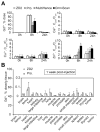Targeted Contrast Agent Specific to an Oncoprotein in Tumor Microenvironment with the Potential for Detection and Risk Stratification of Prostate Cancer with MRI
- PMID: 28201871
- PMCID: PMC6075728
- DOI: 10.1021/acs.bioconjchem.6b00719
Targeted Contrast Agent Specific to an Oncoprotein in Tumor Microenvironment with the Potential for Detection and Risk Stratification of Prostate Cancer with MRI
Abstract
Accurate detection and risk stratification are paramount to the clinical management of prostate cancer. Current diagnostic methods, including prostate specific antigen (PSA) screening, are unable to differentiate high-risk tumors from low-risk tumors, resulting in overdiagnosis and overtreatment. A peptide targeted contrast agent, ZD2-Gd(HP-DO3A), specific to an oncoprotein in tumor microenvironment, EDB-FN, was synthesized for noninvasive detection and characterization of aggressive prostate cancer. EDB-FN, one of the subtypes of oncofetal fibronectin, is involved in tumor epithelial-to-mesenchymal transition (EMT), which is implicated in drug resistance and metastasis. The EDB-FN mRNA level in the metastatic PC3 cells was at least three times higher than that in non-metastatic LNCaP cells. In tumors, EDB-FN protein was highly expressed in PC3 tumor xenografts, but not in LNCaP tumors, as revealed by Western blot analysis. ZD2-Gd(HP-DO3A) produced over two times higher contrast-to-noise ratio in the PC3 tumors than in the LNCaP tumors in contrast-enhanced MRI during 30 min after injection. ZD2-Gd(HP-DO3A) possessed high chelate stability against transmetalation and minimal tissue accumulation. Our results demonstrate that molecular MRI of EDB-FN with ZD2-Gd(HP-DO3A) can potentially be used for noninvasive detection and risk stratification of human prostate cancer. Incorporation of this targeted contrast agent in the existing clinical contrast enhanced MRI procedures has the potential to improve diagnostic accuracy of prostate cancer.
Figures







Similar articles
-
Magnetic resonance molecular imaging of metastatic breast cancer by targeting extradomain-B fibronectin in the tumor microenvironment.Magn Reson Med. 2018 Jun;79(6):3135-3143. doi: 10.1002/mrm.26976. Epub 2017 Oct 29. Magn Reson Med. 2018. PMID: 29082597 Free PMC article.
-
Targeted Contrast Agents for Magnetic Resonance Molecular Imaging of Cancer.Acc Chem Res. 2022 Oct 4;55(19):2833-2847. doi: 10.1021/acs.accounts.2c00346. Epub 2022 Sep 19. Acc Chem Res. 2022. PMID: 36121350
-
Optimization of ZD2 Peptide Targeted Gd(HP-DO3A) for Detection and Risk-Stratification of Prostate Cancer with MRI.ACS Med Chem Lett. 2018 Jun 6;9(7):730-735. doi: 10.1021/acsmedchemlett.8b00172. eCollection 2018 Jul 12. ACS Med Chem Lett. 2018. PMID: 30034609 Free PMC article.
-
Multiparametric magnetic resonance imaging of the prostate: technical aspects and role in clinical management.Top Magn Reson Imaging. 2014 Aug;23(4):243-57. doi: 10.1097/RMR.0000000000000027. Top Magn Reson Imaging. 2014. PMID: 25099562 Review.
-
Clinical and imaging tools in the early diagnosis of prostate cancer, a review.JBR-BTR. 2010 Mar-Apr;93(2):62-70. doi: 10.5334/jbr-btr.121. JBR-BTR. 2010. PMID: 20524513 Review.
Cited by
-
Noninvasive assessment and therapeutic monitoring of drug-resistant colorectal cancer by MR molecular imaging of extradomain-B fibronectin.Theranostics. 2020 Sep 8;10(24):11127-11143. doi: 10.7150/thno.47448. eCollection 2020. Theranostics. 2020. PMID: 33042274 Free PMC article.
-
Magnetic resonance molecular imaging for non-invasive precision cancer diagnosis.Curr Opin Biomed Eng. 2017 Sep;3:67-73. doi: 10.1016/j.cobme.2017.11.003. Epub 2017 Nov 16. Curr Opin Biomed Eng. 2017. PMID: 30272041 Free PMC article.
-
Synthesis and assessment of ZD2-(68Ga-NOTA) specific to extradomain B fibronectin in tumor microenvironment for PET imaging of pancreatic cancer.Am J Nucl Med Mol Imaging. 2019 Oct 15;9(5):216-229. eCollection 2019. Am J Nucl Med Mol Imaging. 2019. PMID: 31772820 Free PMC article.
-
Preclinical Assessment of the Effectiveness of Magnetic Resonance Molecular Imaging of Extradomain-B Fibronectin for Detection and Characterization of Oral Cancer.Mol Imaging Biol. 2020 Dec;22(6):1532-1542. doi: 10.1007/s11307-020-01524-6. Epub 2020 Aug 12. Mol Imaging Biol. 2020. PMID: 32789648 Free PMC article.
-
Preparation and Evaluation of ZD2 Peptide 64Cu-DOTA Conjugate as a Positron Emission Tomography Probe for Detection and Characterization of Prostate Cancer.ACS Omega. 2019 Jan 31;4(1):1185-1190. doi: 10.1021/acsomega.8b02729. Epub 2019 Jan 14. ACS Omega. 2019. PMID: 30729224 Free PMC article.
References
-
- Roobol M. Perspective: Enforce the clinical guidelines. Nature. 2015;528:S123. - PubMed
-
- Qaseem A, Barry MJ, Denberg TD, Owens DK, Shekelle P Clinical Guidelines Committee of the American College of P. Screening for prostate cancer: a guidance statement from the Clinical Guidelines Committee of the American College of Physicians. Ann Intern Med. 2013;158:761–9. - PubMed
-
- Siegel R, Naishadham D, Jemal A. Cancer statistics, 2012. CA Cancer J Clin. 2012;62:10–29. - PubMed
-
- Glass AS, Cary KC, Cooperberg MR. Risk-based prostate cancer screening: who and how? Curr Urol Rep. 2013;14:192–8. - PubMed
Publication types
MeSH terms
Substances
Grants and funding
LinkOut - more resources
Full Text Sources
Other Literature Sources
Medical
Research Materials
Miscellaneous

